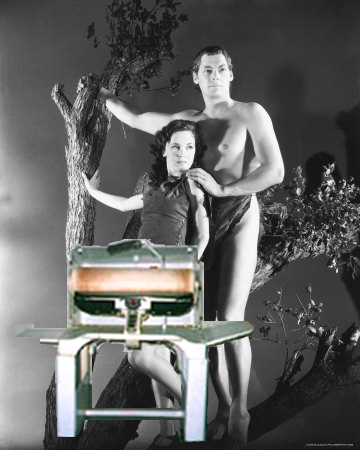
Explore the IRONRITE Ironer
Scene from: Tarzan's Laundry in the Sky, Universal, 1938
Exciting things are hiding in the laundry room...
Here's the IRONRITE!

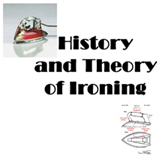
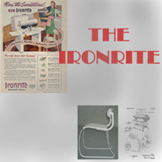
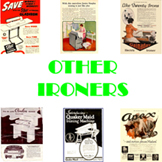
For those of you who don't like buttons, here is a more analytical index to help you find your way to just what you're looking for.
- The Ironrite Ironer [This Page]
- Introducing The Ironrite
- The Ironrite Health Chair
- Oiling the Machine and All About that Special Ironrite Oil...
- Electrical Problems
- Heating Element
- All About Motors
- Replacing the Cord on the IronriteA>
- Changing the Roll or Muslin on the Ironrite
- A Source for Repair Information
- Ironrite Promotional Trinkets
- Ironrite Manuals Available for Free
- Help Us Find Louise!
- The Ironrite and the Cosntitution
- Ironrite Movies That You Can Watch
- The Built-In Ironrite
- Heating Element
- Theory and History of Ironing [Separate Page]
- Why Are We Doing This?
- Early Ironing
- Critical Dimensions of Ironing
- Mrs. Potts and the Sad Iron
- The American Beauty Iron
- The Pyrex Silver Streak Iron
- The Pettipoint Winged Iron
- The Iron Handle
- The Thermostat
- The Winstead-Singer Durabilt Travel Iron
- Steam Irons
- The Future
- Underwriters Laboratory Standards for Irons
- Starch - the Old Fashioned Way
- Etymology of the Dreaded "M" Word
- Replacement Cords for Appliances
- Other Mechanical Ironers [Separate Page]

Join Us on Facebook
Ironing Machines
It was a wonderful day in December, 1999 when I walked into a yard sale in Fairfax. There was a beautiful IronRite Model 85 (i.e from the late 1940s) in immaculate shape. Better yet, the folks at the yard sale had NO IDEA WHATSOEVER of what it was. They said that I could have the thing if I would haul it away. And that I did.
I RAN to the computer and sent fellow collector Chris B. a note. She was kind enough to send me an owners' manual. When I opened the book, I was stunned to find a little anthropomorphic representation of my machine that had morphed into a "French Maid" -- a head with a little dust cap growing out of the top roll and arms coming out of the sides and a short skirt apron and stockings -- stockings, mind you -- growing out of the bottom, possibly suggesting that your ironing machine may be wearing a garter belt... or one of those waist-cinchers... See what you think:
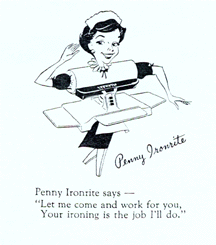
Penny Iron-Rite
Roll Over, Dr. Freud!
This effectively targets both the Men (who would have had to pay for the thing back then) and the Women (who forsee a bit of added leisure). It sure sells the thing better than calling it a "mangle". Even though I got it for free, I was very willing to welcome Penny Ironrite into my home. Any of our readers who just happen to have a maid's uniform would also be quite welcome, by the way....
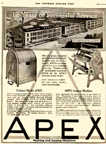
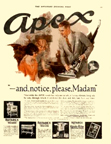
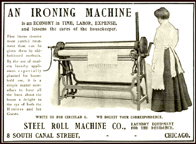
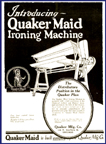
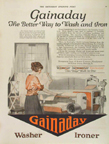

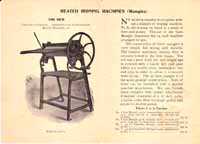
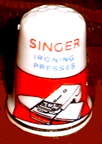

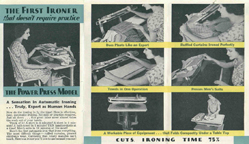

Advertisements for Early Mechanical Ironers
Top Row: Apex, Steel Roll, Quaker Maid
Middle Row: Gainaday, Gem, Singer
Bottom Row: Horton, Meadows, Kenmore
Click to Enlarge
My research has identified a competitive market for mechanical ironing devices that predates the Ironrite by at least 30 years, if not more. The principal difference is that the Ironrite placed the mechanical ironer within the resources of "normal" people. As you'll see in the above ads, most of the early ironers were fairly bulky and (if the graphics are any indicator) were targeted at households that had plenty of servants.

Join Us on Facebook
The Ironrite
The following ad shows that increased leisure time was a very big factor in selling the Iron Rite. The lady of the house could fulfil her duties in a much shorter amount of time while offering her family much more in the way of laundered goods. It is almost inconceivable today in 2005 that women actually though that way in 1948...
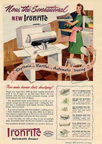

Ironrite Ads from the 1940s
Rhythmic, Restful, Automatic Ironing
Santa may have some problems getting it down the chimney
Click to Enlarge
Briefly, the company was founded by Herman A. Sperlich and Johannes M. Uhlig in the early part of the 20th Century. They started in Detroit and eventually moved to Mt. Clemens, Michigan where they became a mainstay of the local economy, providing about 400 jobs until the factory closed in the late 1950s. I received this interesting note and photograph from reader Joe in Michigan:
"... I have always been told that the house I bought was owned by a man who owned an 'Iron company'. (Coming from Detroit, I thought they meant something like Great Lakes Steel.) But the local Mt. Clemens, MI Secretary has a picture of the Ironrite company and I believe that my house was the residence of the president. I have not heard a whole lot about him other than a story that he liked his dogs very much. He built a fence around the property and made more room in the back yard by moving the maid's quarters to a lot on the other side of the street. The house is turning 101 this year ..."
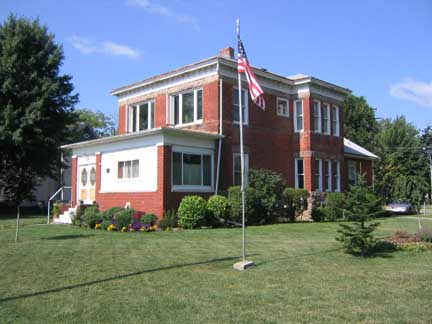
Mr. Sperlich's Residence, sans fence
Penny can Walk Across the Street
Mr. Sperlich was certainly a busy fellow when he wasn't playing with his dogs behind that high fence. He amassed over 14 patents on the IronRite alone. Here are the critical drawings for the models issued in the 1940s through the 1950s. Although we have scanned a copy of the Service Manual, if you are repairing or restoring an IronRite, you should get the full-sized patent drawings from the US Patent and Trademark Website by following these simple instructions (all you have to do is enter the patent number..)




Mr. Sperlich's Definitive 1944 Patent No. 2,349,014
Click to Enlarge
Click here if you want to learn how to get Free Patent Drawings
Here are all the other patents that I have found.
- 1,670,387 2-May-1928 Original Design
- 1,918,502 18-Jul-1933 Knee Controls
- 2,032,188 7-May-1935 Cabinet
- D 112,453 6-Dec-1938 Health Chair Design
- 2,314,173 16-Mar-1943 Support
- 2,323,580 6-Jul-1943 Roll Cover
- 2,349,014 6-May-1944 Updated Design
- 2,372,270 27-Mar-1945 Ironing Shoe and Wiring
- 2,482,380 7-Oct-1947 Fuse
- 2,648,147 11-Aug-1953 Updated Design
- 2,688,199 7-Sep-1954 Updated Design
- 2,711,600 28-Jun-1957 Updated Design
- 2,777,223 15-Jan-1957 Updated Design
- 2,809,847 15-Oct-1957 Frame and Leveling Device
- 2,261,496 1941 Heating Element
- 2,729,903 1956 Release Mechanism
- 2,689,469 1954 Stabilizing Holder
- 2,854,785 1958 Cabinet Stabilizer
You can patent the exterior appearance of an object as well -- these patents are always prefaced by the letter "D". During the 1950s, a "design patent" for a fairly cheesy cabinet for the Iron Rite was issued. (c.f. the blue arrow in the ad reproduced above) I don't like this nearly as much as the Art Deco styled cabinets of the 1940s and 1950s. See for yourself:
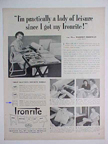


Ironrite Design Patents
left: Ironrite Ad from the late 1950s Blue arrow marks the cheesy "modern" cabinet
middle: 1935 Design Patent D-95,552 by Messrs Sperlich and Mr. Ulich
right: 1957 Design Patent D-179,520 by Mr. Mollhagen Click to Enlarge
Click here if you want to learn how to get Free Patent Drawings
Here are some scans of documents illustrating the method for "setting up" the Ironrite once it has been removed from its shipping crate.

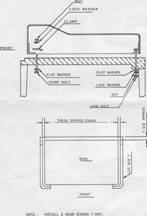
Setting the Ironrite Up
We are grateful to our friend Chris H-S for sending these documents
Click to Enlarge and Rotate
Here are some pictures of the somewhat rarer Ironrite Model 88, which is the basic machine in a wood-tone cabinet. [Some were actually made in genuine Mahogany!] It resembles a waterfall chest-of drawers. This did not sell particularly well, possible because the antiseptic white porcelain case seems much more aesthetically suited to the laundry -- and was most likely easier to clean!
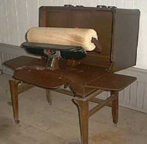
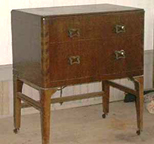
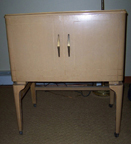
The Wood-tone Ironrite Model 88 (light and dark)
We are grateful to our friend Chris H-S for sending the photo of the somewhat rare limed oak model
Click to Enlarge
Here is the Ironrite Model 95, the ironer for the Space Age. It has all the elements of the Model 85 but came in this wonderful beige color with "up-to-date" typography for those Fabulous Fifties!
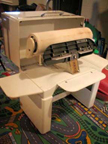
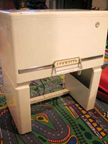
The Space-Age Ironrite Model 95
Click to Enlarge
Apparently, it was possible to buy an Ironrite without the cabinet. here are some photos of such a machine that were sent in by one of our readers
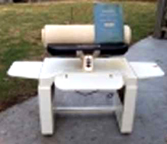
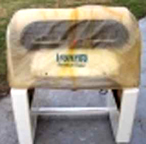
The "Naked" Ironrite
Note the special plastic cover
Click to Enlarge
As the 1940s moved on, families were somewhat cramped for space. Ironrite introduced a "portable" model that had even less metal than the "naked" model above. Our guess is that this was done in response to the Thor Gladiron, discussed in our page on Other Ironer Brands.
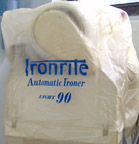
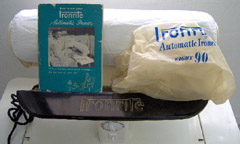

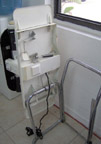
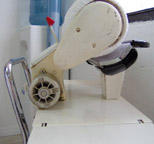
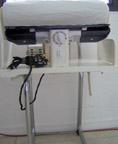
The Model 890 "Portable" Ironrite
I, personally, am not thrilled with those flimsy legs...
Click to Enlarge
In this 1928 patent Mr. Sperlich used the dreaded "M" (mangle..) word -- probably long before he got a Public Relations Department. Helene Uhlig has the patent for the Roll. Apparently, in Mt. Clements, writing patents was a family affair.


Family Patents
Mr. Sperlich's original 1928 Patent No. 1,670,387
Mrs. Uhlig's Patent for the Roller 2,323,580
Click to Enlarge
Click here if you want to learn how to get Patent Drawings
After some practice, I have mastered the machine to the point where I can iron formal shirts with pleats on the front. This machine is absolutely wonderful --- it puts a knife-sharp crease in trousers and does wonders on sheets, pillowcases, etc,etc. This is a real advantage in my war with the evil Dry Cleaners.
My advice is: look for an IronRite and grab it if you can. It is MUCH easier than using a flatiron and a board. You will never regret it! Drop us a line if you need a copy of the owner's manual!
Here's what Marion (one of our readers) has to say about her Ironrite:
I remember many happy hours with that mangle - when I was a kid my Mom taught me how to use it and I got good enough to do shirts. We would be in the sewing room doing the ironing - some with the iron, some with the mangle and talking away. My Mom who is now 83 moved in with me this summer because she can no longer live alone. In cleaning out her house my brother and I both put dibs on the mangle - he wanted to turn it into a rotisserie! Imagine! I do tons of sewing - I design professionally for collectable doll companies and I also do the costuming for a folk dance group - the mangle will be a wonderful tool for me. Mom is really happy to see it put to good use and I will have it rolling away much faster due to your speedy reply..."
Remember -- this is an Ironer, not a "mangle"
About that "Special Ironrite Oil""...
Many of my readers have asked about the "Special Ironrite Oil" that is discussed in the manual. Indeed, Ironrite sold oil in a can that looked like this:
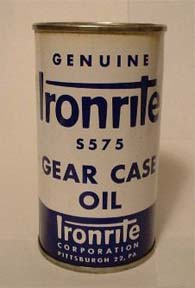
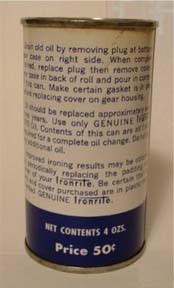
A Can of IronRite Special Oil
Just SAE50 Gear Oil
This is about the size of an orange juice concentrate can
The product is not "special" at all - it is simply a lightweight gear oil (SAE50) that was packaged for Ironrite by the Gulf Oil Company. Any good lightweight oil will work just fine.
It is important that the gear housing on the Ironrite have good oil to maintain correct lubrication of the gears inside. After many years, the oil becomes sludge in the bottom of the machine. If you have never replaced the oil on your ironer, it is probably due. However, a machine that does not leak will only require an oil change once every two or three years. It is important to clean the housing as best you can prior to replacing the oil. I use some throwaway cloth rags in the bottom to soak up what does not come out of the drain hole, which is at the lower right side on most machines, but above the table.
The Ironrite takes only 6 ounces of oil. More can cause splashed oil to leak into the motor housing. The Ironrite likes a light weight oil. The automotive oils are normally too heavy. I recommend a jack or hydraulic oil. For those with exotic tastes, Royal Purple, available at hot rod shops is the premier oil, while "Three-in-One, available at supermarkets, will work just fine.
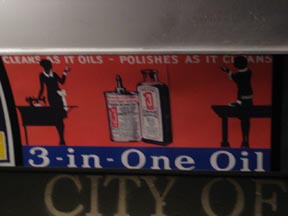
Subway Advertising Card for Three-in-One Oil
The "Three" are (1)Cleaner (2) Lubricant (3) Polish
This was on our Nostalgia Subway Ride, Christmas 2008
Click to Enlarge
The paper over the gears (gasket), under the top cover, is supposed to be there, so make sure you put it back. It is a splash shield.
Speaking of leakage, the gear case oil will also leak out into the motor when the machine is tipped on it's side. This normally occurs when moving the machine. It makes quite a mess. The Ironrite must be kept upright when loading and unloading, or else the gear oil must be drained for moving.
Fixing Some Electrical Problems...
Electrical Cords - if your circuit breaker flips or any other strange electrical things happen:
- Your cord might be at fault for the circuit breaker flip. Reset the breaker and start the machine again.
- Feel the cord and see if it is getting hot.
If either of these things happen, replace the cord immediately. Put on a grounded cord. The ground lead, (green wire), can attach to the bottom of the casting somewhere near where the cord goes into the machine.
Replacing the Cord
This will fix about 80% of the problems associated with your Ironrite when you first get it. Everything else is built like a tank, but the old cloth-covered cord is no match for time, moisture or mice. FORTUNATELY, our reader Silas has compiled a "How to Do It" .pdf that is lavishly illustrated. Please Contact Me and I will send you this very informative guide.
The Heating Element...
Many of our readers turn on their Ironrite and find that the iron won't heat. This is MOST LIKELY due to a wiring glitch caused by fraying of the old cloth-covered wires. There isn't a whole lot to the heating element that can go wrong, so don't immediately jump to the conclusion that NO Heat = Bad Element. Here is the Patent for the Heating Element -- click to download it and learn how it works.
All About Motors
The motor in the Ironrite is known in the trade as a split-phase induction motor. It has two separate coils (windings of wire.)
- One set is wound to provide high torque for starting the motor and turning the gears. This winding uses considerable current.
- The second winding is the running winding, designed to sustain the motor speed under normal working load. This winding uses much less electric current
The winding selection (starting vs running) is done by a small electric switch contained within the motor and mounted on the front (gear box) end of the armature (rotating part of the motor). This switch has two small weights which are forced outward by centrifigal force as the motor comes up to operating speed. When stopped, the centrifugal switch contacts connect to the starting winding and when the motor reaches operating speed (in less than 1 second
The starting switch connects the starting winding in parallel with the run winding until the motor comes up to speed at which time the centrifugal mechanism disconnects the start winding. The start winding (which is wound of fewer turns of finer wire) will quickly overheat and burn out if left on too long. The contacts of the starting switch are affixed to the motor end frame on the gearbox end. The centrifugal weight mechanism rotates with the rotor.
The Smoking Motor
If this centrifugal switch sticks for any reason, the contacts will stay connected to the starting coils. Recall that they use a great deal of electric current; that is they get hot very quickly. This is the source of the heat which causes the smoke. If you let the motor run in this position, it will quickly overheat the coils, destroy the insulation on the wire, short out the coil, and ruin the motor. The cure when smoke is noticed, is to disassemble the motor and clean the switch mechanism of old oil and lint. Any commercial electronic contact cleaner may be used for this; a cotton swab can also be helpful. Most aerosol contact cleaning solvents or electric motor cleaning solvents (available at auto parts stores) are not flammable. Simply clean the contacts and the centrifugal mechanism with the solvent, being careful not to get any into the motor's bearings. While you're at it, clean the rest of the motor's interior, including the windings. Then, if desired, lightly lubricate the centrifugal mechanism with a DRY SILICONE lubricant. Don't use oil-it will attract and trap lint and dust-and DON'T USE GRAPHITE because it conducts electricity and will short out the motor.
Dianne, one of our readers sent us this note:
"... Just wanted to let you know that:
1. Mark at Taylor Electric has done work on Ironrite motors; phone 313-565-0510
2. We were able to find replacement casters for our Ironrite at:
12200 Farmington Rd.
Livonia, MI
734-522-1885
Do you have anything that you'd like to share with the Ironrite community? Any special tips, sources for replacement parts, folks with expertise -- anythng. All you have to do is Contact Me.
A Source For Repair Information
Mister Mangle is a new web site for those that want step-by-step guidance, with photos, for locating, inspecting, buying, transporting, and maintaining Ironrite ironing machines (mangles). Although it specializes in Model 85 Ironrites, the site is useful for other models as well.
The Ironrite Health Chair
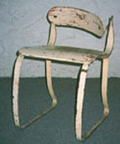
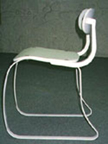
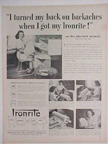
The Ironrite Health Chair
Note that the lovely Mrs. Belmont Morgan is using a Model 85 Health Chair
Click to Enlarge
About a month after I found the IronRite machine, I was at an estate sale in Bethesda. Off in the corner was a beat-up molded plywood chair. Upon examination, I was STUNNED to find that this was an IronRite Health Chair, the official chair that goes with my machine. Not only that, it is the appropriate chair for the Model 85! (The later model [95] featured a chair with a reinforcing splat between the legs...) As you can see, a considerable amount of work was required to get this back in shape. Lord knows what the odds against repeating this feat are.. Well, good things come to those who search.
At the right is an ad in which a Mrs. Belmont Morgan (sounds ritzy, doesn't it...) got rid of her backache by using the Ironrite and its Health Chair. It probably gave her more time for tennis...
The Health Chair should have the authentic Ironrite Decal on the back. Here is a closeup of what it looks like. Unfortunately, the decal is placed right in the center of the back, right where one might hold the chair; in many cases the decal is worn away
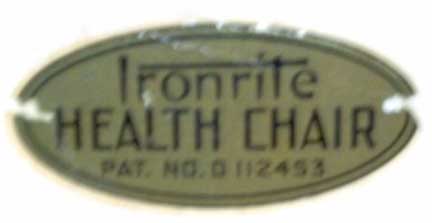
The Official decal from the Ironrite Health Chair
Like everything else about the Ironrite, the Health Chair was invented by Mr. Herman Sperlich, founder, CEO and chief cook & bottle washer for the Ironrite Company. Here is his design patent for the chair, issued in December of 1938, and for reasons discussed below, it is shown next to the patent for a "spring steel chair" developed by Famous Artist Marcel Breuer
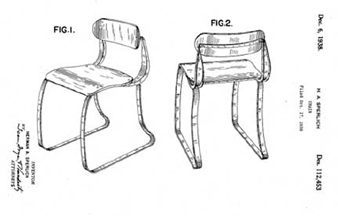
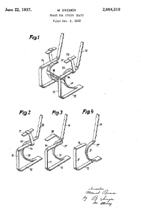
Spring Chair Designs
Ironrite Health Chair Patent D-112,453
Marcel Breuer Spring Chair Patent No. 2,084,310
It looks like Breuer beat Mr. Sperlich by at least a year...
Click to Enlarge It
Click here if you want to learn how to get Free Patent Drawings
One of our readers found a Health Chair in its ORIGINAL BOX. The reader was kind enough to share this with our Facebook Page and we are putting it here for the benefit of those who are not Fans.
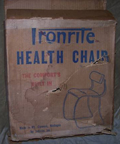
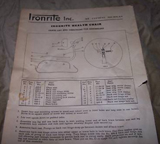
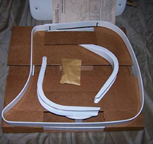

Box, Directions, Layers
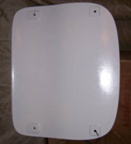
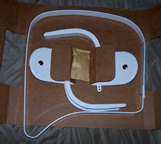
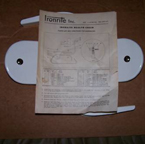
Seat, legs, back
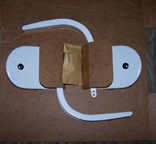



Ironrite Health Chair, New In the Original Box
IKEA has nothing on Mr. Sperlich, packaging-wise
Click to Enlarge
FRAUD WARNING
Recently, the onlline auctions have been offering the Ironrite Health Chair as if it were an art object! One ad offered an "Authentic Herman Sperlich Health Chair" and wanted something like $500 for it. I think that the intention was to confuse you with Herman Miller a company that actually does make art furniture. One online auction was particularly outrageous when it linked the name of the inventive, dog-loving Mr. Sperlich with that of Marcel Breuer who has been described variously as a "genius" or a "crank":
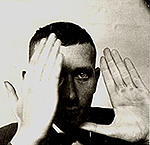
Marcel Breuer
One of the Founders of the Internationalist Style
I really don't want to get into a discussion of the merits of the International Style other than the fact that it was developed by Communists in pre-WWII Germany but became the dominant genre for 1960s Corporate America. The Wassily Chair (below) was found ubiquitously in the lobby of PanAm, AT&T and other behemoths that have long been extinct. I think that the appeal of this chair for lobbies is that it is uncomfortable and you can't sit in it for very long. I have no idea how this is derived from Marxist doctrine other than a clever very-long-range Bolshie Plot to make Capitalists uncomfortable...
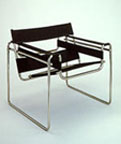
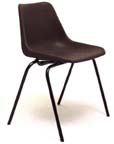
(l.) The Wassilly Chair (r.) The Robin Day Polyprop Chair
You can't sit in either for very long!
The Ironrite Health Chair is actually quite comfortable. However, it isn't "high art" and it isn't worth a whole lot of money. Mr. Sperlich was a brilliant engineer, but he is just a normal guy as far as "art" is concerned. And, as you can see above, Mr. Breuer beat Mr. Sperlich to the punch by at least a year...
Ironrite Promotional Incentives
The Ironrite came with a "Guarantee Bond" as shown below. If you read it carefully, it says that for a year they will replace parts that are ..judged defective by the Company.. Otherwise,the machine should work perfectly. Also included with a new ironer was a brochure describing some "optional accessories" like the Health Chair, the "Lite-Site" lamp, and replacement rollcovers and pads.
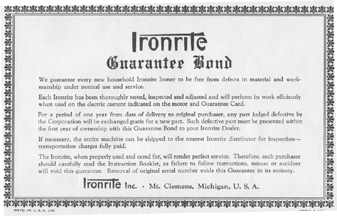

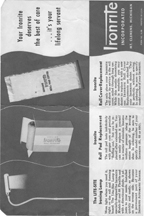
Ironrite Guarantee Bond and Accessories
We are grateful to our friend Chris H-S for sending these documents
Click to Enlarge and Rotate
Click Here to download a ".pdf" of these supplementary documents for your use.
When the Ironrite Corporation wasn't using guarantees or status-envy to sell these machines, they used some rather expensive premiums. Here is a Ironrite Charm Bracelet that was given away to prospective customers:
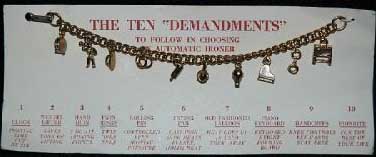
Ironrite Promotional Charm Bracelet
- Clock: Ironing time cut by 2/3
- Weight Lifter: Saves tons of lifting
- Hand Iron: 2 do-all ironing points
- Twin Rings: Twin open ends
- Rolling Pin: Controlled even ironing pressure
- Frying Pan: Cast-iron shoe heats evenly, holds heat
- Old Fashioned Balloon: Heat goes up is used then away
- Piano Keyboard: Keyboard height forming board
- Handcuffs: Knee controls let hands stay free
- Ironrite: for the rest of your life
The charm bracelet is approximately 7 inches long and seems to be very well made. Here is another Ironrite premium -- it is a very nice (and heavy) glass paperweight
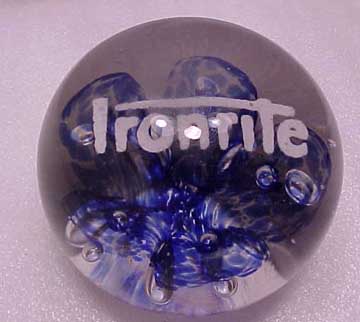
Ironrite Promotional Paperweight
In today's dollars, an Ironrite would cost about $3,000. Salesmen probably found it worthwhile to give away an expensive premium to induce someone to make such a large purchase.
Here is yet another Ironrite Novelty -- this time, a pair of plastic salt shakers. These were probably given to the casual customers that were not as good a prospect as those deemed worthy of the paperweight or the charm bracelet:
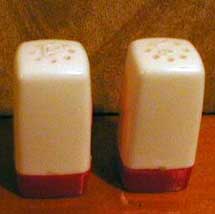
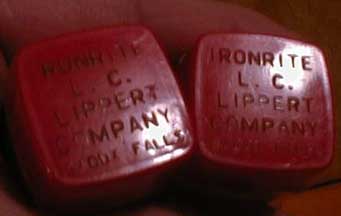
Ironrite Promotional Saltshakers
Here are some toys that allow even the youngest home maker to use an ironer:
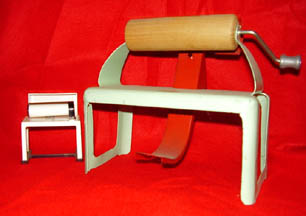
Toy Ironing Machines
Click to Enlarge
Here is an original "Hang-Tag" that was attached to an Ironrite cord to inform the prospective buyer of all the wonderful features of this device.
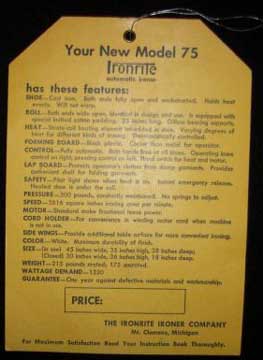
Ironrite Hang Tag
Here is a neon clock that probably hung in an Ironrite dealership.
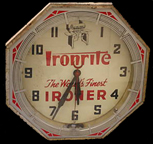
An Ironrite Neon Clock
Click to Enlarge
Our reader saw something interesting - here's what he has to say:
"... was in my hometown, Dimmitt, Texas, over the weekend and stopped by an old hardware store that has been closed for as long as I can remember (we moved to there in 1967). Kerr Hardware was apparently run by Mr. Kerr who died unexpectedly and his family just closed up shop and left it the way it was. I took some pictures this weekend to attach to a facebook page about our hometown. I was trying to identify the appliances to get an idea of when the store closed and came across your page while looking for "Ironrite". ..."
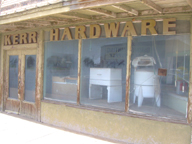
Encased in Time
Click to Enlarge
Changing the Muslin or the Pad
The covers get scorched after about 6-10 months of use.
In the old days, people were expected to "make their own" replacement covers. I have never seen a "new" or "factory-made" cover.
In general, the "cover" has two parts:- the outer fabric which is cheap unbleached muslin
- the inner fabric which is burlap
The muslin attaches with a drawstring at the end. To take it off, you must fish out the ends (they are usually tucked in), and untie the drawstring. You may now unroll the muslin. Next, unroll the burlap.
The burlap should be "freshened" by shaken and aired. DON'T WASH THE BURLAP. If it is damaged, simply buy more burlap at a fabric store and cut it to match. Buy unbleached muslin and duplicate the muslin cover that came with your machine (it is just a rectangle with a hem to hold the drawstring...)
The fun part is putting it back on...
- Set the thermostat on LOW and allow the iron to become warm
- Adjust the burlap on the iron and under the roll so that 1 1/2 turns are on the roll and the rest hangs down facing you.
- VERY SLOWLY, rotate the roller until you get all but 10 inches of the burlap on the roll. Make sure that the burlap is centered on the roll and that none of it sticks over either end.
- place the end of the muslin on top of the burlap end and feed iit slowly through the machine intil the muslin is entirely on the roll.
- Lock the roll against the iron and tie off the drawstring on the muslin. Tuck the ends into the roll so that they don't show.
I had this note from one of my readers:
"... I made covers from Muslin but they kept scorching and didn't last long enough to suit me so I made a couple from a lightweight canvas material. That was three years ago and I'm still using the first one. I made a new pad from two layers of cotton batting sewed together -about 12 years ago. It fluffs up in the dryer in about 10 minutes. I finally replaced the original burlap 2 years ago. I attached the burlap to the roller with duct tape instead of what looked like shellac or some ancient hide glue. ..."

Join Us on Facebook
My friend Chris B selflessly gave me a copy of her Ironrite Owners Manual. Recently, Mike Twomey sent me a copy of the Ironrite Service Manual. I have decided to return the favor by making them available to all my readers. The Owners Manual teaches you how to use the machine and the Service Manual tells you how to fix things that may go wrong.
If you are struggling with a balky IronRite, here are the chapters in the Service Manual:
And now, for something different:
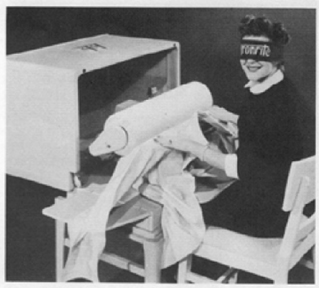
So Easy You Can Do It Blindfolded
Warning: Do Not Attempt
Professional ironer on a closed course
Click to Enlarge
We saw this Ironrite Model 85 at Mamie's an "Old-Timey" restaurant in Aberdeen, Maryland. The place serves lots of good old American cooking at low prices. A decidedly nice place to visit, made even better by a fairly large display of artifacts from the 1950s.
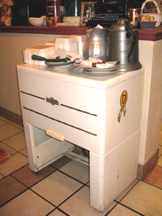
Ironrite Model 85 at Mamie's Restaurant, Aberdeen, Maryland
Click to Enlarge
We are grateful to our friend Chris H-S for sending this photo.
I made a PDF of both manuals, but they are fairly large, the reason why it is not available directly on the website.
- If you have a very high speed connection, send me an e-mail and I'll e-mail the Owner's Manual to you. This works fine for cable modems and DSLs. You'll need to be able to receive a 6.8 MB file for the Owners Manual (lots of pictures) and a 3.0 MB file for the Service Manual
- If you want a photocopy of either IronRite manual, I'll do the copying, but you'll have to pay the postage. The Owner's Manual is 44 pages and the Service manual is 33 pages (single sided) so you'll have to put enough postage on the envelope to get 44 (03 33) pages from my home in Washington DC to your house. This comes out to about $3.50 in most cases. I'd rather not have my address on the internet, so send me an e-mail and I'll give you the details.
My friend Chris H-S sent me a second Ironrite Owner's Manual that is probably from the late 1950s. It is largely the same as the one that Chris B. gave me. (Maybe only women named "Chris" saved their manual... or were willing to share it with me...) On Page 3, we noted that someone wrote "Louise Bryan Hancock 66400" -- as shown below:

Do You Know Anything About Louise?
Click to Enlarge
On the back of the manual, the Ironrite Company mentions that they feature a "unique Home Demonstration Service."
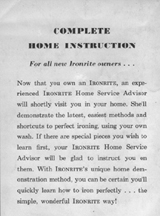
Ironrite Home Demonstration Service
Click to Enlarge
We think that Louise was employed as a "Home Demonstrator" for the Ironrite Company, possibly in the area of Roxbury, Massachusetts (or West Roxbury...)
We're not sure about Louise's name. There are two possibilities:
- "Louise Bryan Hancock" ...or
- "Louise Bryan" whose phone number was HAncock 6 -6400
We're inclined toward the latter, since "HAncock - 6" was a legitimate Boston telephone exchange in the 1950s.
Our reader Betty from Houston has an Ironrite and sent this along, more-or-less confirming that "HAncock" was the telephone exchange:
" .... was reading your website for info on Ironrite. (I've got one from my mom's estate), and saw your inquiry about Louise Bryan (Hancock). I like to do these kind of people search things. I did a quick check of SS death index, and find a Louise K. Bryan, born 1905, died 1995, who lived in Attleboro, Bristol, MA. I can't be sure that this is her, but I did a search for Louise Bryan, and Louise Hancock, and this was the only Louise from Massachusetts ... her husband's name was Vernon J Bryan, b. 1990, d. 1989. Their names appear on those in attendance at a funeral in 1968, at Elm St. Baptist church. I also found reference to "Katherine Louise Bryan" who received a Bachelors degree from Wellesley College in 1936..."
So, if you know anything about Louise or the Ironrite dealership in Boston in the late 1950s, Contact Us. If you don't know about this "Telephone Exchange" business, take a peep at our Vintage Telephone Page.As part of our investigation of popular culture in the 1930s, we came across the following article in the September 1939 issue of Popular Mechanics:

Ironrites at the National Archives
Click to Enlarge
It seems that the National Archives had acquired 58 Ironrites to smooth out historical documents. Possibly the Constitution went in for a quick press.
The website Archive.Otg has a lot of interesting Retro movies that can be played (streaming video) or downloaded. There are three Ironrite Films that should be of great interest to you:
Making a New Day out of Tuesday - Part II (1946)
Mother Takes a Holiday (1952)
All three films are replete with marvelous retro images and filmed in glorious Technicolor. If you combine the two "Make a New Day" films with the Owner's Manual, you can get to be pretty good at using the IronRite
Our reader Ray sent in the following pictures of an Ironrite that had been built-in. As shown, the machine appears to be an innocuous group of cabinets. However, like one of those Japanese monsters, the thing magically transforms into an Ironrite station. Note the little half-moon in front of the forming board that allows the Health Chair to be hidden along with the machine. This is a very clever installation!
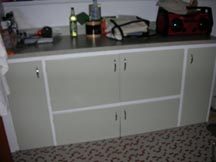
The Built-in Ironrite
We saw this prewar (pre-WWII, that is...) Ironrite at an open house for an Art Deco house that was being sold. The owners made a plywood top to sit on the cabinet to increase workspace when the ironer was not in use
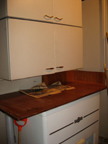
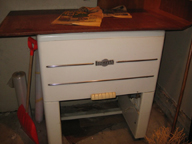
1940 Ironrite
Click to Enlarge

Join Us on Facebook
Home | About Lindy | 1940s Collectibles | Upcoming Events | Vintage Clothing
The Guide - Establishments - Travel - Accessories
Music | Links | Photo Gallery | Extras | Contact